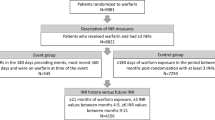Abstract
Bivalirudin may cause a falsely prolonged international normalized ratio (INR) that complicates the discontinuation of bivalirudin when used as a bridge to warfarin. To prospectively validate our novel bivalirudin to warfarin transition nomogram, adult patients who received bivalirudin as a bridge to warfarin between July 2015 and June 2016 were prospectively evaluated, utilizing our predictive nomogram. The major outcome of our analysis was the correlation between the predicted change in INR upon bivalirudin discontinuation based on the nomogram, and the actual change in INR upon bivalirudin discontinuation. The major outcome was analyzed using the Pearson’s correlation test. A Pearson’s correlation coefficient >0.6 was considered to be a strong correlation. Bivalirudin was used as a bridge to warfarin in 29 patients. The majority of patients (86%) included in the analysis had a ventricular assist device. The median initial bivalirudin rate was 0.07 mg/kg/h and the mean increase in INR when starting bivalirudin was 0.6. The mean final weight-based bivalirudin rate was 0.08 mg/kg/h and the mean change in INR after stopping bivalirudin was 0.7. The Pearson correlation coefficient between the predicted change in INR upon bivalirudin discontinuation and the actual change in INR upon bivalirudin discontinuation was 0.86 (p < 0.001). After bivalirudin discontinuation, 68% of patients had a therapeutic INR. The results of this prospective analysis successfully validated our novel bivalirudin to warfarin transition nomogram. There was a very strong correlation between the predicted change and actual change in INR upon bivalirudin discontinuation.



Similar content being viewed by others
References
Sheth SB, DiCicco RA, Hursting MJ, Montague T, Jorkasky DK (2001) Interpreting the international normalized ratio (INR) in individuals receiving argatroban and warfarin. Thromb Haemost 85:435–440
Warkentin TE, Greinacher A, Koster A. Bivalirudin (2008) Thromb Haemost 99:830–839
Gosselin RC, Dager WE, King JH, Janatpour K, Mahackian K, Larkin EC, Owings JT (2004) Effect of direct thrombin inhibitors, bivalirudin, lepirudin, and argatroban, on prothrombin time and INR values. Am J Clin Pathol 121:593–599
Warkentin TE, Greinacher A, Craven S, Dewar L, Sheppard JA, Ofosu FA (2005) Differences in the clinically effective molar concentrations of four direct thrombin inhibitors explain their variable prothrombin time prolongation. Thromb Haemost 94:958–964
Methodist Healthcare (2015) Heparin-induced thrombocytopenia (DTI) protocol—bivalirudin http://www.methodistmd.org/dotAsset/29dc4dc7-12fd-4c89-8498-94f26a075478.pdf. Accessed 7 Oct 2015
Rollins AR, Smith KE, Zemrak WR (2016) Implementation of a simplistic bivalirudin-warfarin transition protocol is associated with improved achievement of INR values within the therapeutic range. Ann pharmacother doi:10.1177/1060028016660989
Sanfelippo MJ, Zinsmaster W, Scherr DL, Shaw GR (2009) Use of chromogenic assay of factor X to accept or reject INR results in warfarin treated patients. Clin Med Res 7:103–105
Hohlfelder B, DeiCicchi D, Sylvester KW, Connors JM (2016) Development of a predictive nomogram for the change in PT/INR upon discontinuation of bivalirudin as a bridge to warfarin. Clin Appl Thromb/Hemostasis doi:10.1177/1076029616638505
Reardon DP, Atay JK, Ashley SW, Churchill WW, Berliner N, Connors JM (2015) Implementation of a Hemostatic and Antithrombotic Stewardship program. J Thromb Thrombolysis 40:379–382
Evans JD (1996) Straightforward statistics for the behavioral sciences. Brooks/Cole Pub. Co, Pacific Grove
McIlvennan CK, Page RL, Ambardekar AV, Brieke A, Lindenfield J (2014) J Heart Lung Transplant 33(12):1312–1314
Adatya S, Sunny R, Fitzpatrick MJ, Colvin M, Thennapan T, John R, Dodge Zantek N, Pritzker M, Eckman P, Uriel N (2016) J Heart Lung Transplant 35(11):1311–1320
Author information
Authors and Affiliations
Corresponding author
Ethics declarations
Conflict of interest
Dr. Connors reports personal fees from Boehringer Ingleheim, personal fees from Bristol Meyer Squibb, and Unum Therapeutics all outside the submitted work. Drs. Hohlfelder, Sylvester, Rimsans and Deicicchi have nothing to disclose.
Rights and permissions
About this article
Cite this article
Hohlfelder, B., Sylvester, K.W., Rimsans, J. et al. Prospective evaluation of a bivalirudin to warfarin transition nomogram. J Thromb Thrombolysis 43, 498–504 (2017). https://doi.org/10.1007/s11239-016-1468-7
Published:
Issue Date:
DOI: https://doi.org/10.1007/s11239-016-1468-7




